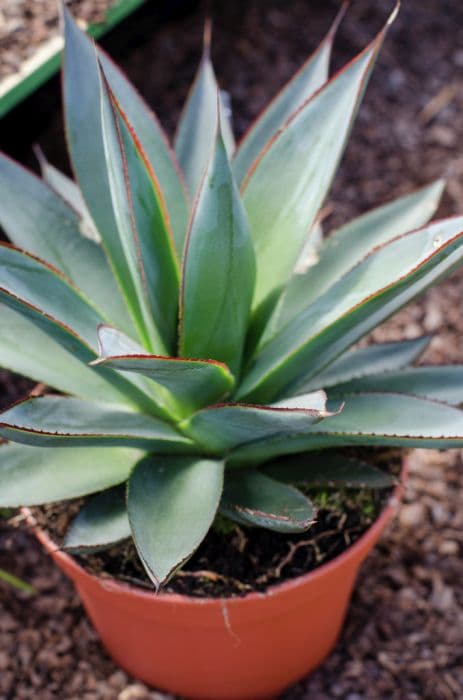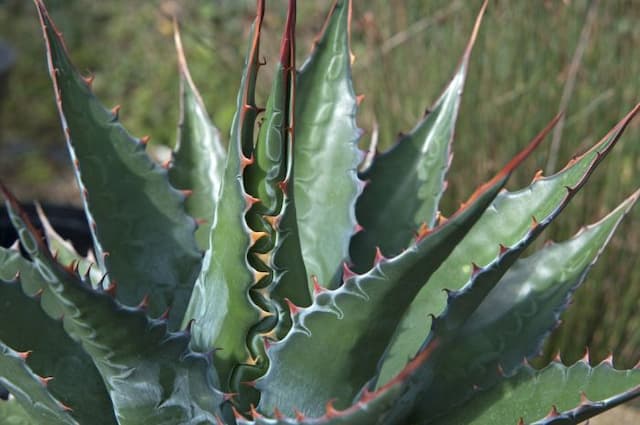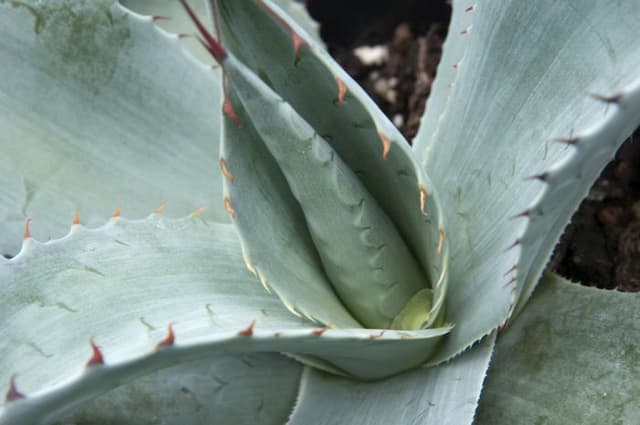Grape Hyacinth Muscari 'Mount Hood'

ABOUT
Muscari 'Mount Hood', commonly known as Grape Hyacinth 'Mount Hood', is a bulbous perennial plant that is appreciated for its attractive spring blooms. The plant produces dense spikes of small, urn-shaped flowers that resemble clusters of grapes, which is where the common name Grape Hyacinth derives from. The flowers are typically a deep, cobalt blue at the bottom, transitioning to a lighter, icy blue or nearly white at the top, reminiscent of the snow-capped peak of its namesake, Mount Hood. This contrasting coloration gives it a distinctive and striking appearance when in bloom. The foliage of Muscari 'Mount Hood' consists of narrow, green, strap-like leaves that are somewhat fleshy and can be quite lush. These leaves emerge from the base of the plant, forming a tuft of green that further accentuates the colorful flower spikes. The foliage often appears before the flowers, providing an early hint of green in the garden before the vivid floral display begins. Overall, Grape Hyacinth 'Mount Hood' is treasured in gardens and landscapes for its vivid blue blooms that provide a burst of color in the spring, as well as for its ease of care and naturalizing ability, which allows it to form impressive drifts of color over time. It is also popular as a cut flower for small spring bouquets and arrangements, where its unique flower spikes can add a touch of whimsy and charm.
About this plant
 Names
NamesFamily
Asparagaceae.
Synonyms
Grape Hyacinth, Bluebell.
Common names
Muscari 'Mount Hood'
 Toxicity
ToxicityTo humans
Grape hyacinth is generally considered to have a low level of toxicity to humans. If ingested, it can potentially cause mild upset stomach, nausea, diarrhea, or vomiting. It is important to be cautious and avoid ingesting any part of the plant.
To pets
Grape hyacinth is also known to be only mildly toxic to pets such as cats and dogs. If a pet consumes parts of the grape hyacinth, it may experience symptoms similar to those in humans, which can include nausea, vomiting, and diarrhea. It is advisable to keep pets away from the plant to prevent any accidental ingestion.
 Characteristics
CharacteristicsLife cycle
Perennials
Foliage type
Deciduous
Color of leaves
Green
Flower color
Blue
Height
6-8 inches (15-20 cm)
Spread
2-3 inches (5-7.5 cm)
Plant type
Bulb
Hardiness zones
4-8
Native area
Southeastern Europe
Benefits
 General Benefits
General Benefits- Aesthetic Appeal: Adds vibrant blue to purple color to gardens and landscapes during its blooming period in spring.
- Low Maintenance: Once established, these hardy plants require minimal care, making them suitable for novice gardeners.
- Drought Tolerance: They can withstand periods of low water, which is beneficial in water-scarce environments or for water-conscious gardeners.
- Pest Resistance: Generally resistant to pests and diseases, reducing the need for chemical treatments.
- Attracts Pollinators: Draws bees and other pollinating insects, which can enhance the productivity of gardens and support local ecosystems.
- Naturalizing: These plants can spread over time, naturalizing an area and creating larger displays of color without additional planting.
- Seasonal Interest: The grape hyacinth provides an early burst of spring color, often when few other plants are blooming.
- Easy to Propagate: Can be propagated easily through division, making it simple to increase your plantings or share with others.
- Versatility: Suitable for a variety of garden settings, including borders, rock gardens, and containers.
- Compact Size: Their small, clumping growth habit makes them ideal for use in small gardens or spaces.
 Medical Properties
Medical PropertiesThis plant is not used for medical purposes.
 Air-purifying Qualities
Air-purifying QualitiesThis plant is not specifically known for air purifying qualities.
 Other Uses
Other Uses- Muscari 'Mount Hood', also known as Grape Hyacinth, can be used for natural dye production. The flowers can be crushed to produce a light blue or purple dye for fabrics and crafts.
- Grape Hyacinth bulbs can be forced indoors during winter for an early spring bloom, offering a touch of color and cheer during the colder months.
- The flowers of the Grape Hyacinth can be used in potpourri mixes because of their shape that adds texture and their subtle fragrance when dried.
- Grape Hyacinth can be planted in outdoor containers and hanging baskets to create a cascading effect of their grape-like flower clusters.
- In floral arrangements, Grape Hyacinth offers a unique vertical element and can be used as a 'filler' to accompany larger blooms.
- When used in companion planting, Grape Hyacinth can help detract certain pests from roses and vegetable gardens because of their strong scent.
- Planting Grape Hyacinth in grassy areas can create a 'naturalized' lawn look, as they spread over time and create a blanket of color every spring.
- The blooms of Grape Hyacinth can serve as an unexpected garnish for springtime dishes, as long as they haven't been treated with pesticides.
- Grape Hyacinth plants can be given as living gifts during the spring season, symbolizing rebirth and the beginning of new ventures.
- These plants can be used in educational settings to teach children about bulb growth and early spring flowering plants.
Interesting Facts
 Feng Shui
Feng ShuiThe plant Grape Hyacinth is not used in Feng Shui practice.
 Zodiac Sign Compitability
Zodiac Sign CompitabilityThe plant Grape Hyacinth is not used in astrology practice.
 Plant Symbolism
Plant Symbolism- Grape Hyacinth: The Muscari 'Mount Hood', commonly known as Grape Hyacinth, typically symbolizes trust and sincerity due to its enduring and hardy nature. It is also often associated with rebirth and determination because it is one of the first flowers to bloom in spring.
- Peace: The cool blue hues of the Grape Hyacinth can symbolize peace and tranquility, evoking a serene atmosphere in gardens and bouquets.
- Constancy: Grape Hyacinth's ability to return each spring with little care represents constancy and reliability.
- Games and Sports: In the language of flowers, Grape Hyacinth also stands for games and sports, probably due to their clustered blooms which could be likened to a group of people engaging in playful activities.
 Water
WaterGrape hyacinths, including 'Mount Hood', should be watered moderately during the growing season, ensuring the soil is kept evenly moist. Typically, this means providing about 1 inch of water per week, whether through rainfall or irrigation. During the dormant period in summer, after the foliage has died back, watering should be reduced significantly to prevent bulb rot. It is best to water these plants deeply and less frequently, as this encourages strong root development. Always check the top inch of soil for dryness before watering again to avoid overwatering.
 Light
LightGrape hyacinths prefer full sunlight to partial shade. The best spot for 'Mount Hood' grape hyacinths is an area that receives at least 6 hours of direct sunlight daily, though they can tolerate some light afternoon shade. They thrive under the bright morning sun, which contributes to the vibrancy and longevity of their blooms.
 Temperature
Temperature'Mount Hood' grape hyacinths are hardy and can tolerate winter temperatures as low as 20°F but ideally prefer a range between 50°F to 75°F during their active growing season. They emerge in late winter to early spring, so they are adapted to cooler temperatures. However, they do not fare well in extremely hot climates and may require some shade in areas where temperatures regularly rise above 75°F.
 Pruning
PruningPruning of 'Mount Hood' grape hyacinths is not necessary for the health of the plant but can be done to maintain tidiness. After flowering, allow the leaves to remain in place as they gather energy for next year's growth. Once the foliage has yellowed and died naturally, usually by late spring or early summer, it can be removed. This is typically the only "pruning" required for grape hyacinths.
 Cleaning
CleaningAs needed
 Soil
SoilGrape Hyacinth (Muscari 'Mount Hood') thrives in well-draining, moderately fertile soil with a pH range of 6.0 to 7.0. A soil mixture incorporating organic material such as compost along with some sand to improve drainage provides an ideal growing medium. It's vital to avoid overly wet or waterlogged conditions which can cause bulb rot.
 Repotting
RepottingGrape Hyacinths, including Muscari 'Mount Hood', do not require frequent repotting as they can be left undisturbed for several years. They should only be repotted or divided if the clumps become overcrowded, which is generally every 3-5 years, preferably after the foliage has died back post-flowering.
 Humidity & Misting
Humidity & MistingGrape Hyacinth (Muscari 'Mount Hood') is adaptable to a wide range of humidity conditions and does not have specific humidity requirements. It is tolerant of the typical humidity levels found in most outdoor garden environments.
 Suitable locations
Suitable locationsIndoor
Place Grape Hyacinth in bright light, cool spot, limit watering in winter.
Outdoor
Plant in full sun to partial shade, in well-drained soil.
Hardiness zone
4-8 USDA
 Life cycle
Life cycleThe Grape Hyacinth 'Mount Hood' begins its life cycle with the germination of hardy, bulbous roots, typically in the fall. After a period of cold dormancy in winter, leaf growth commences in early spring, with narrow, green leaves emerging from the soil. As temperatures rise, flower stalks develop, bearing dense clusters of cobalt-blue, urn-shaped flowers that resemble bunches of grapes, usually blooming in mid to late spring. Following the flowering period, the plant's foliage continues to photosynthesize and store energy in the bulb before it yellow and dies back as summer progresses. The bulb enters a period of dormancy during the hot summer months. The cycle restarts when cooler temperatures return in the fall, prompting the next season's growth from the now re-energized bulb.
 Propogation
PropogationPropogation time
Early spring
Grape Hyacinth 'Mount Hood' can be propagated most effectively through division. This process is ideally undertaken in the late summer to early fall, after the foliage has died back and the plants are dormant. To propagate by division, the bulbs should be carefully dug up and the offsets, which are the small bulbs attached to the main bulb, should be gently separated. These offsets can then be replanted immediately at a depth of approximately 3 inches (7.6 centimeters), with spacing of about 3 inches apart to provide enough room for growth. This method of propagation allows for the rapid increase of your Grape Hyacinth 'Mount Hood' collection and will typically result in blooms within one to two growing seasons.









